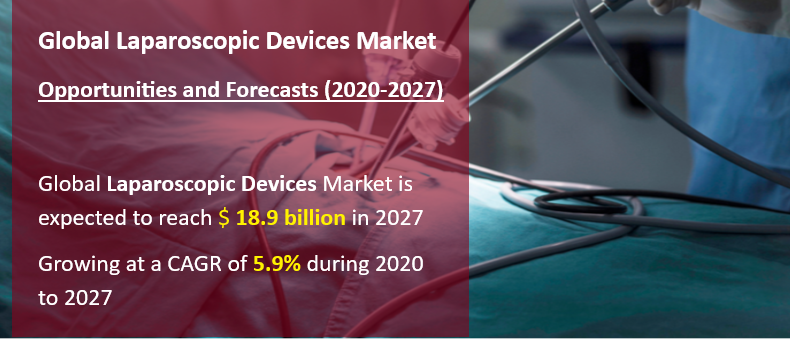Report Overview
The report will cover the overall analysis and insights in relation to the size and growth rate of the ” Global Laparoscopic Devices Market ” by various segments at a global and regional level for the 2014-2027 period, with 2014-2018 as historical data, 2019 as a base year, 2020 as an estimated year and 2020-2027 as forecast period.
A laparoscope comprises a long, thin tube with high intensity light along with high resolution camera in front. The camera transmits images to monitor as it travels through the abdomen. Laparoscopy is used for diagnosis as well as treatment of endometriosis, ectopic pregnancy, pelvic inflammatory disease (PID), cysts, and fibroids. Laparoscopy devices are routinely used in diagnosis as well as in therapeutic procedures of various diseases such as prostatectomy, pancreatic cancer, and gastrointestinal disorders. Use of these devices in surgical procedures ensure minimal bleeding and assist in maintaining hemostasis.
COVID 19 Impacts on Laparoscopic Devices
COVID-19 is a new strain of coronavirus that has not been previously identified in humans . Coronaviruses (CoV) are a family of RNA (ribonucleic acid) viruses. COVID-19 started in Asia and is now spreading over the rest of the world via person-to-person contact and community spread. COVID-19 pandemic may have an potential impacts on Global Laparoscopic Devices Market.
Report Includes
- An overview of the current and future characteristics of the global market for Laparoscopy.
- Analyses of global market trends estimates for 2027 and projections of compound annual growth rates (CAGRs) through 2027.
- A look at major changes in market behavior, such as acquisitions, mergers, and alliances by companies and global organizations.
- To analyze the Laparoscopy with respect to individual growth trends, future prospects, and their contribution to the total market.
- 45+ data tables and 35 additional tables.
- Detailed discussion regarding impact of product on demand.
- The report focuses on detailed profile of major leading industry players with information such as company profiles and specification, capacity, production, price, cost, revenue and contact information.
- To share detailed information about the key factors influencing the growth of the market (growth potential, opportunities, drivers, industry-specific challenges and risks).
- Coverage of historical overview, key industrial development and regulatory framework.
- A look at the opportunities in the market for stakeholders and provide a competitive landscape of the market leaders.
- Key market players within the laparoscopy devices market are profiled in this report and their strategies are analyzed thoroughly, which helps in understanding competitive outlook of global laparoscopy devices market.
Scope of the reports
This report provide details regulatory aspects; innovations and technological improvements, including patents and approvals; and latest trends, preferences and progress in the Laparoscopic Devices market. The report analyzes the global Laparoscopic Devices market by category, region, country, end user and application. North America (U.S. and Canada), Europe (France, Germany, Italy, the U.K., Russia, Spain), and emerging markets (many Asian countries, South Korea, parts of Africa, Brazil, India, China) are considered in the regional market analysis. In addition, the study also covers the market projections, market leaders, and market shares in the worldwide market for Laparoscopic Devices.
An increase in the number of patients suffering from gall bladder problems, Crohn’s diseases, ulcerative colitis, diverticulitis, and obesity are a few factors driving the market. Laparoscopy is a minimally invasive technique used for performing surgeries, such as bariatric, gynecologic, and gall bladder surgery.
In addition, increasing cases of obesity and urological diseases are expected to contribute to market growth. Bariatric surgeries are performed to treat obesity. Such surgeries lead to weight loss by restricting the amount of food storage in the stomach. The most common bariatric surgeries are gastric bypass, adjustable gastric band, sleeve gastrectomy, and Biliopancreatic (BPD) diversion with the duodenal switch.
Segments covered in the reports
- On the Basis of Region: North America, Europe, Asia-Pacific and Lamea.
- On the Basis of Countries: United States, Russia, China, Germany, United Kingdom, France, Japan, Israel, Saudi Arabia, South Korea, United Arab Emirates, Canada, Switzerland, Australia, India, Italy, Sweden, Spain, Belgium, Netherlands, Norway, Italy, Brazil, Argentina, Mexico, South Africa and others.
- On the Basis of Application: General Surgery, Gynecological Surgery, Colorectal Surgery, Urological Surgery, Bariatric Surgery, and Others
- On the Basis of Product: Laparoscopes(Video Laparoscopes and Fiber Laparoscopes), Energy Devices, Access Devices, Accessories, Suction or Irrigation Systems, Closure Devices, Hand Instruments, Insufflators, Robot-Assisted Surgical Systems and Others.
- On the Basis End-User: Clinics, Hospitals and Others.
Major participants in the global Laparoscopic Devices market are:
PLC, Karl Storz GmbH, Stryker Corp., Johnson and Johnson Services Inc., CONMED Corp., Olympus Corp B. Braun, 3M, Reach Surgical, Purple Surgical, Panther Healthcare, Frankenmann, Microline Surgical, Teleflex Medical, Applied Medical, Haida Medical, and others.
Objectives of the study
To provide detailed information regarding drivers, restraints, opportunities and challenges are influencing the growth in the respective market. To analyze the competitive intelligence of players based on company profiles and their key growth strategies. To strategically analyze micro markets with respect to the individual growth trends, their prospects, and their contribution to the total respective market. To analyze competitive developments such as expansions, and product launches, along with research & development (R&D) activities undertaken in the respective market. A unique model is created customized for each study also offers suggestions that help enterprises to identify and mitigate risks.
Note –
- Global Industry Reports will also support you post-purchase for a period of 6 months to answer any of your queries related to the following market and to provide you any more data if you need, for your analysis.
- Also, you can buy some selected Chapters from the report.
FREQUENTLY ASKED QUESTIONS?
- What is the total market value?
- What will be the growth in 2027?
- What are the key trends in the market?
- What are the major players in the markets?
- What are the key growth strategies of industry players?
- Which region would offer a higher growth?
- What are the countries included in the rest of the word segments?
- How can I get report sample?










